Providing Guidance for Controlling and Prevention of Noise in UK Hospitals
VerifiedAdded on 2023/04/04
|16
|3137
|154
AI Summary
This research aims to provide guidance and control measures for preventing noise in hospitals in the UK. It explores the effects of noise, sources of noise, and measures to prevent and control noise in UK hospitals.
Contribute Materials
Your contribution can guide someone’s learning journey. Share your
documents today.
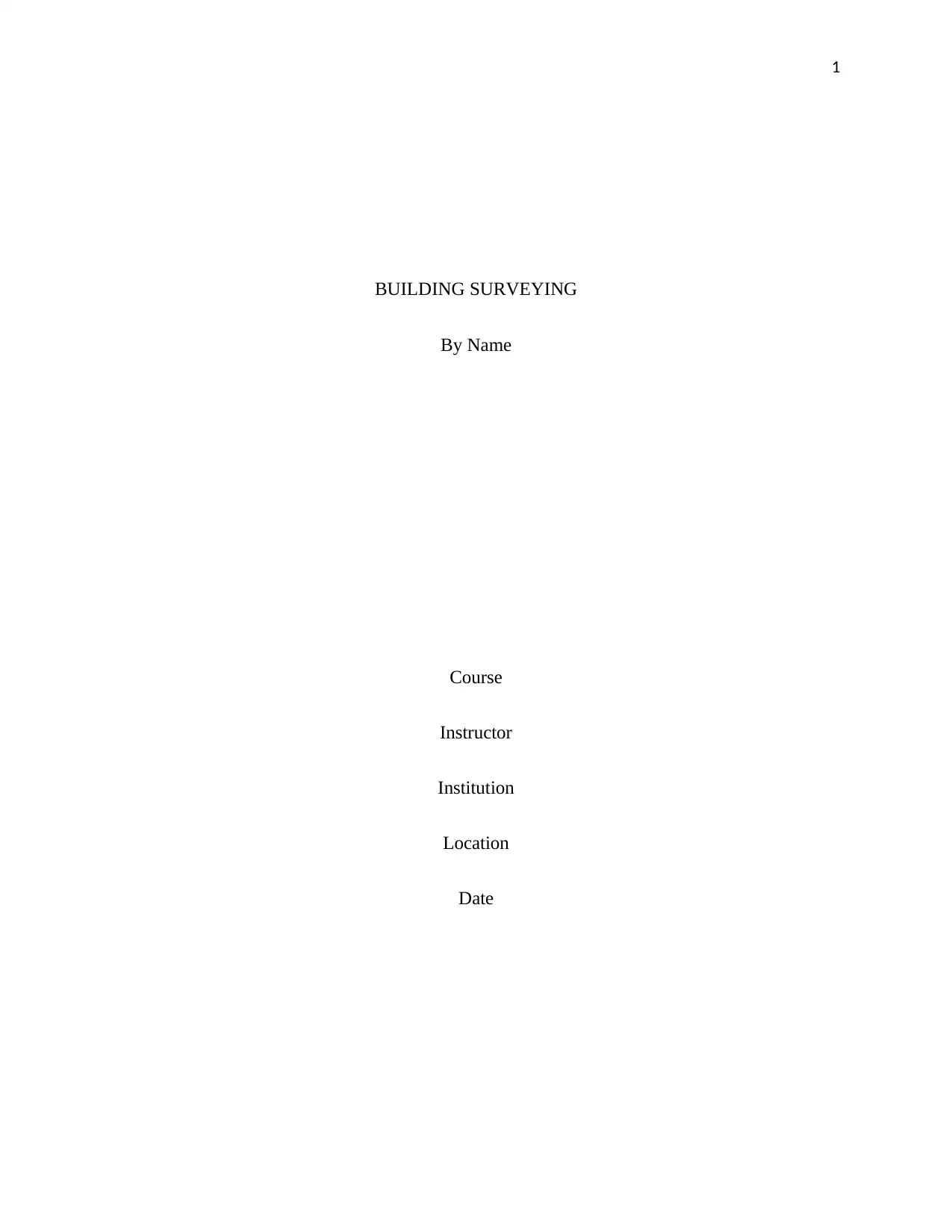
1
BUILDING SURVEYING
By Name
Course
Instructor
Institution
Location
Date
BUILDING SURVEYING
By Name
Course
Instructor
Institution
Location
Date
Secure Best Marks with AI Grader
Need help grading? Try our AI Grader for instant feedback on your assignments.

2
PROVIDING GUIDANCE FOR CONTROLLING AND PREVENTION OF NOISE IN
UK HOSPITALS
Introduction
Reducing the level of noise as much as possible so that patients can heal and rest in comfort is a
great challenge for most hospitals in the United Kingdom. Achieving the required noise levels in
Hospitals is not an easy job considering the level of activities going on in a typical hospital in the
UK. Noise in its different manifestations can have a serious impact on the staff, patients and the
visitors (Hurtley, Night Noise Guidelines for Europe, 2018). It is well established that the
majority of Hospital in the United Kingdom is extremely noise, exceeding the recommended
guidelines regarding the Hospital Noise levels. Noise is defined as ‘unwanted sound, can be
detrimental to the staff and patient health. Speech is intelligibility and audibility is very
important for the patients and staff to communicate which each other in the hospital. Also, if the
personal patient information which is being discussed between the healthcare provider and the
patients is overheard by other patients and staff, it can lead to a serious breach of the patient
confidentiality, and the issues of speech security and speech privacy come to the fore. With this
different aspect of sound which ranges from speech intelligibility, stressful noise to speech
privacy calls for guidelines for the control of noise in hospitals in the United Kingdom
(Organization, 2014).
Aims and objectives
The main aim of this research is to provide guidance and control measures of preventing the
noise in hospitals in the United Kingdom. With that there are a number of specific objectives
which were set to assist in achieving the main aim of the research and they include;
PROVIDING GUIDANCE FOR CONTROLLING AND PREVENTION OF NOISE IN
UK HOSPITALS
Introduction
Reducing the level of noise as much as possible so that patients can heal and rest in comfort is a
great challenge for most hospitals in the United Kingdom. Achieving the required noise levels in
Hospitals is not an easy job considering the level of activities going on in a typical hospital in the
UK. Noise in its different manifestations can have a serious impact on the staff, patients and the
visitors (Hurtley, Night Noise Guidelines for Europe, 2018). It is well established that the
majority of Hospital in the United Kingdom is extremely noise, exceeding the recommended
guidelines regarding the Hospital Noise levels. Noise is defined as ‘unwanted sound, can be
detrimental to the staff and patient health. Speech is intelligibility and audibility is very
important for the patients and staff to communicate which each other in the hospital. Also, if the
personal patient information which is being discussed between the healthcare provider and the
patients is overheard by other patients and staff, it can lead to a serious breach of the patient
confidentiality, and the issues of speech security and speech privacy come to the fore. With this
different aspect of sound which ranges from speech intelligibility, stressful noise to speech
privacy calls for guidelines for the control of noise in hospitals in the United Kingdom
(Organization, 2014).
Aims and objectives
The main aim of this research is to provide guidance and control measures of preventing the
noise in hospitals in the United Kingdom. With that there are a number of specific objectives
which were set to assist in achieving the main aim of the research and they include;

3
1. To identify the various controls and preventions related to noise in hospitals of the UK by
using survey base analysis and qualitative investigation
2. To find out the effects of noise in hospitals (Council, 2012)
3. To find out the sources of noise in United Kingdom-Hospitals
4. To determine the measures and practices which should be put in place to prevent and
control noise in United Kingdom hospitals
Research hypothesis
The research is carefully crafted to prove or disprove the hypothesis that;
1. There is a significant impact of using softer material like carpet, foam padding and fiberglass
on noise prevention and absorption in hospitals of UK
2. There is not a significant impact of using softer material like carpet, foam padding and
fiberglass on noise prevention and absorption in hospitals of UK
Research questions
The research will be guided by the following research questions;
1. What are the various controls and prevention of noise in hospital in the UK?
2. What are the various type of material or softer material that can be used to absorb noise in the
hospital of the UK?
3. What are the various construction methods that can be used to absorb noise pollution in
hospitals in the UK?
Significance of the research
1. To identify the various controls and preventions related to noise in hospitals of the UK by
using survey base analysis and qualitative investigation
2. To find out the effects of noise in hospitals (Council, 2012)
3. To find out the sources of noise in United Kingdom-Hospitals
4. To determine the measures and practices which should be put in place to prevent and
control noise in United Kingdom hospitals
Research hypothesis
The research is carefully crafted to prove or disprove the hypothesis that;
1. There is a significant impact of using softer material like carpet, foam padding and fiberglass
on noise prevention and absorption in hospitals of UK
2. There is not a significant impact of using softer material like carpet, foam padding and
fiberglass on noise prevention and absorption in hospitals of UK
Research questions
The research will be guided by the following research questions;
1. What are the various controls and prevention of noise in hospital in the UK?
2. What are the various type of material or softer material that can be used to absorb noise in the
hospital of the UK?
3. What are the various construction methods that can be used to absorb noise pollution in
hospitals in the UK?
Significance of the research
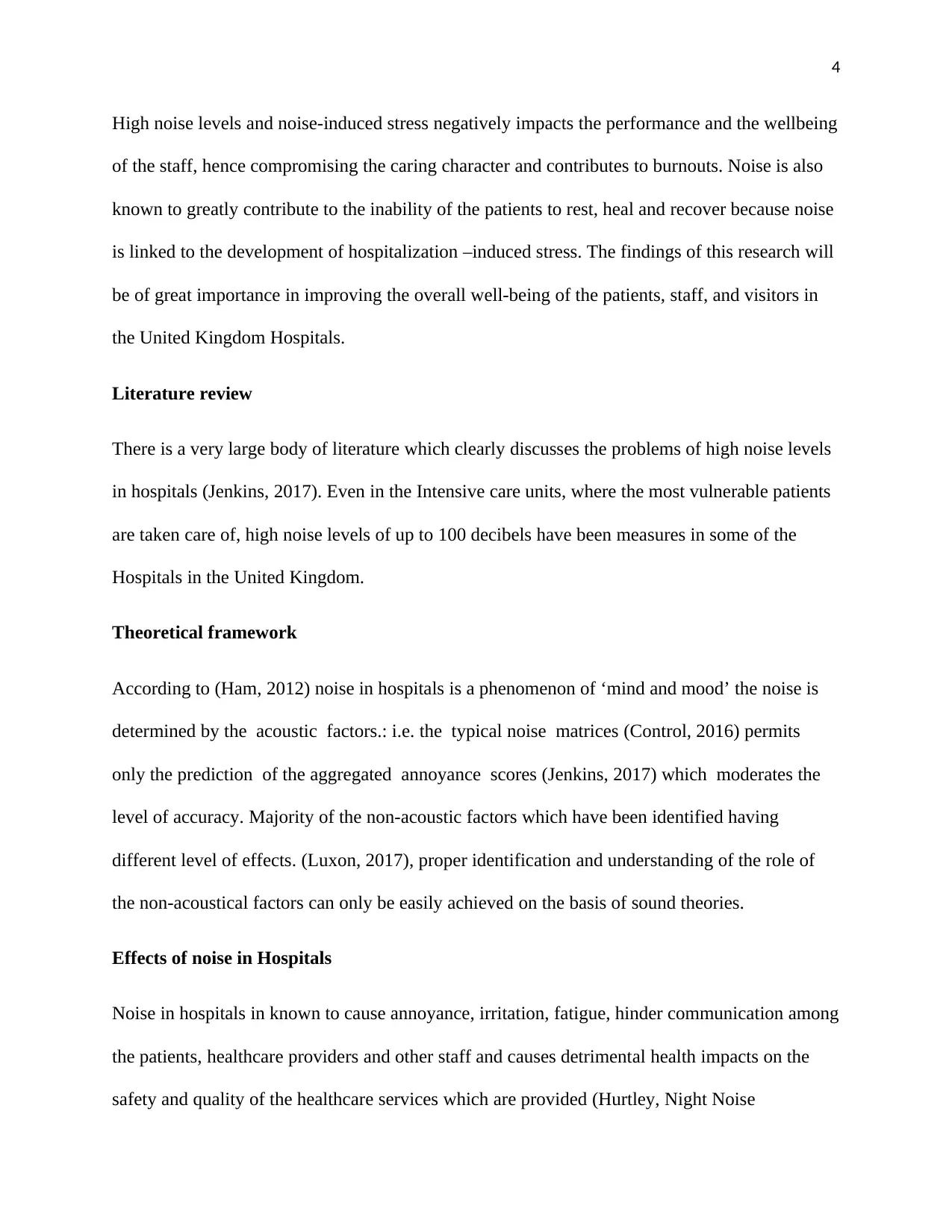
4
High noise levels and noise-induced stress negatively impacts the performance and the wellbeing
of the staff, hence compromising the caring character and contributes to burnouts. Noise is also
known to greatly contribute to the inability of the patients to rest, heal and recover because noise
is linked to the development of hospitalization –induced stress. The findings of this research will
be of great importance in improving the overall well-being of the patients, staff, and visitors in
the United Kingdom Hospitals.
Literature review
There is a very large body of literature which clearly discusses the problems of high noise levels
in hospitals (Jenkins, 2017). Even in the Intensive care units, where the most vulnerable patients
are taken care of, high noise levels of up to 100 decibels have been measures in some of the
Hospitals in the United Kingdom.
Theoretical framework
According to (Ham, 2012) noise in hospitals is a phenomenon of ‘mind and mood’ the noise is
determined by the acoustic factors.: i.e. the typical noise matrices (Control, 2016) permits
only the prediction of the aggregated annoyance scores (Jenkins, 2017) which moderates the
level of accuracy. Majority of the non-acoustic factors which have been identified having
different level of effects. (Luxon, 2017), proper identification and understanding of the role of
the non-acoustical factors can only be easily achieved on the basis of sound theories.
Effects of noise in Hospitals
Noise in hospitals in known to cause annoyance, irritation, fatigue, hinder communication among
the patients, healthcare providers and other staff and causes detrimental health impacts on the
safety and quality of the healthcare services which are provided (Hurtley, Night Noise
High noise levels and noise-induced stress negatively impacts the performance and the wellbeing
of the staff, hence compromising the caring character and contributes to burnouts. Noise is also
known to greatly contribute to the inability of the patients to rest, heal and recover because noise
is linked to the development of hospitalization –induced stress. The findings of this research will
be of great importance in improving the overall well-being of the patients, staff, and visitors in
the United Kingdom Hospitals.
Literature review
There is a very large body of literature which clearly discusses the problems of high noise levels
in hospitals (Jenkins, 2017). Even in the Intensive care units, where the most vulnerable patients
are taken care of, high noise levels of up to 100 decibels have been measures in some of the
Hospitals in the United Kingdom.
Theoretical framework
According to (Ham, 2012) noise in hospitals is a phenomenon of ‘mind and mood’ the noise is
determined by the acoustic factors.: i.e. the typical noise matrices (Control, 2016) permits
only the prediction of the aggregated annoyance scores (Jenkins, 2017) which moderates the
level of accuracy. Majority of the non-acoustic factors which have been identified having
different level of effects. (Luxon, 2017), proper identification and understanding of the role of
the non-acoustical factors can only be easily achieved on the basis of sound theories.
Effects of noise in Hospitals
Noise in hospitals in known to cause annoyance, irritation, fatigue, hinder communication among
the patients, healthcare providers and other staff and causes detrimental health impacts on the
safety and quality of the healthcare services which are provided (Hurtley, Night Noise
Secure Best Marks with AI Grader
Need help grading? Try our AI Grader for instant feedback on your assignments.
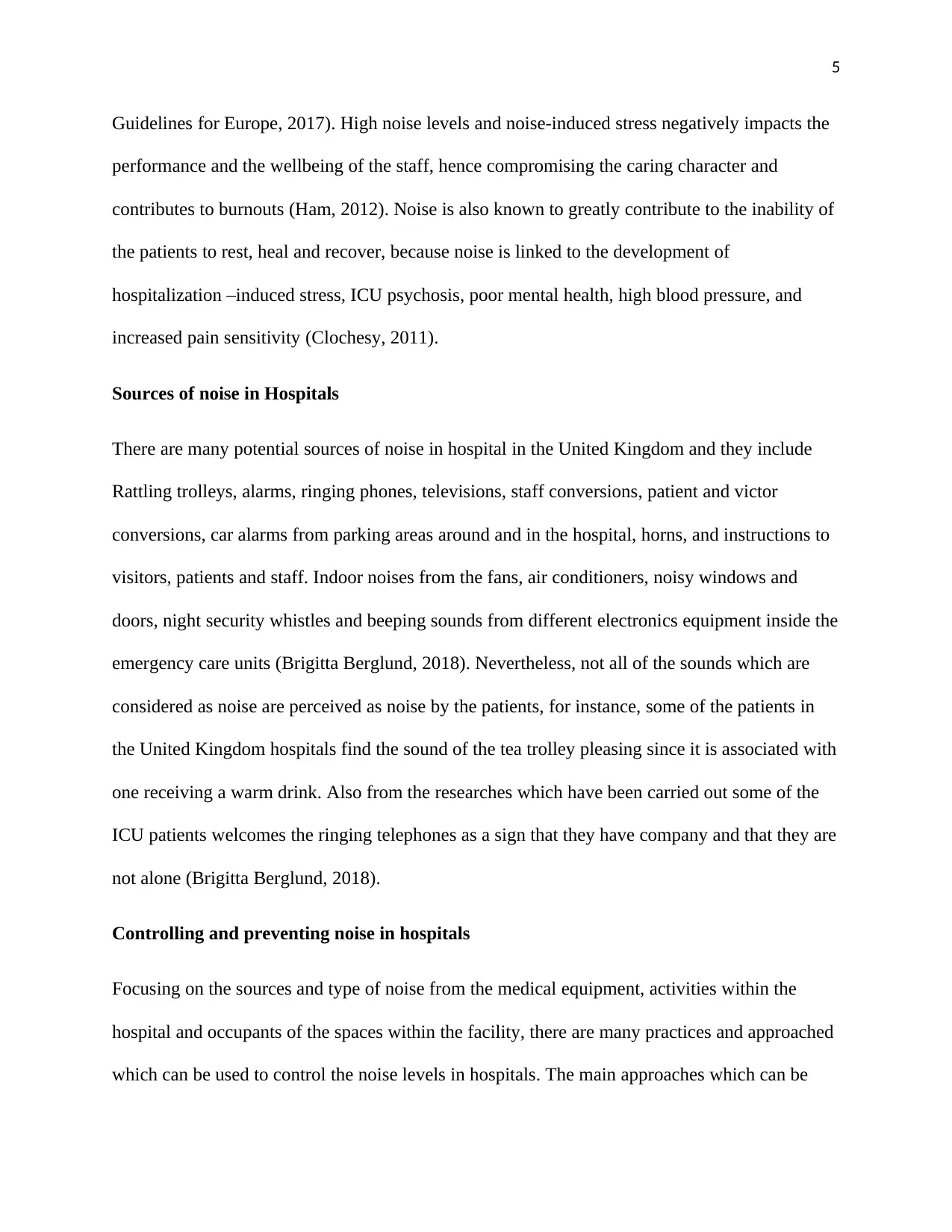
5
Guidelines for Europe, 2017). High noise levels and noise-induced stress negatively impacts the
performance and the wellbeing of the staff, hence compromising the caring character and
contributes to burnouts (Ham, 2012). Noise is also known to greatly contribute to the inability of
the patients to rest, heal and recover, because noise is linked to the development of
hospitalization –induced stress, ICU psychosis, poor mental health, high blood pressure, and
increased pain sensitivity (Clochesy, 2011).
Sources of noise in Hospitals
There are many potential sources of noise in hospital in the United Kingdom and they include
Rattling trolleys, alarms, ringing phones, televisions, staff conversions, patient and victor
conversions, car alarms from parking areas around and in the hospital, horns, and instructions to
visitors, patients and staff. Indoor noises from the fans, air conditioners, noisy windows and
doors, night security whistles and beeping sounds from different electronics equipment inside the
emergency care units (Brigitta Berglund, 2018). Nevertheless, not all of the sounds which are
considered as noise are perceived as noise by the patients, for instance, some of the patients in
the United Kingdom hospitals find the sound of the tea trolley pleasing since it is associated with
one receiving a warm drink. Also from the researches which have been carried out some of the
ICU patients welcomes the ringing telephones as a sign that they have company and that they are
not alone (Brigitta Berglund, 2018).
Controlling and preventing noise in hospitals
Focusing on the sources and type of noise from the medical equipment, activities within the
hospital and occupants of the spaces within the facility, there are many practices and approached
which can be used to control the noise levels in hospitals. The main approaches which can be
Guidelines for Europe, 2017). High noise levels and noise-induced stress negatively impacts the
performance and the wellbeing of the staff, hence compromising the caring character and
contributes to burnouts (Ham, 2012). Noise is also known to greatly contribute to the inability of
the patients to rest, heal and recover, because noise is linked to the development of
hospitalization –induced stress, ICU psychosis, poor mental health, high blood pressure, and
increased pain sensitivity (Clochesy, 2011).
Sources of noise in Hospitals
There are many potential sources of noise in hospital in the United Kingdom and they include
Rattling trolleys, alarms, ringing phones, televisions, staff conversions, patient and victor
conversions, car alarms from parking areas around and in the hospital, horns, and instructions to
visitors, patients and staff. Indoor noises from the fans, air conditioners, noisy windows and
doors, night security whistles and beeping sounds from different electronics equipment inside the
emergency care units (Brigitta Berglund, 2018). Nevertheless, not all of the sounds which are
considered as noise are perceived as noise by the patients, for instance, some of the patients in
the United Kingdom hospitals find the sound of the tea trolley pleasing since it is associated with
one receiving a warm drink. Also from the researches which have been carried out some of the
ICU patients welcomes the ringing telephones as a sign that they have company and that they are
not alone (Brigitta Berglund, 2018).
Controlling and preventing noise in hospitals
Focusing on the sources and type of noise from the medical equipment, activities within the
hospital and occupants of the spaces within the facility, there are many practices and approached
which can be used to control the noise levels in hospitals. The main approaches which can be
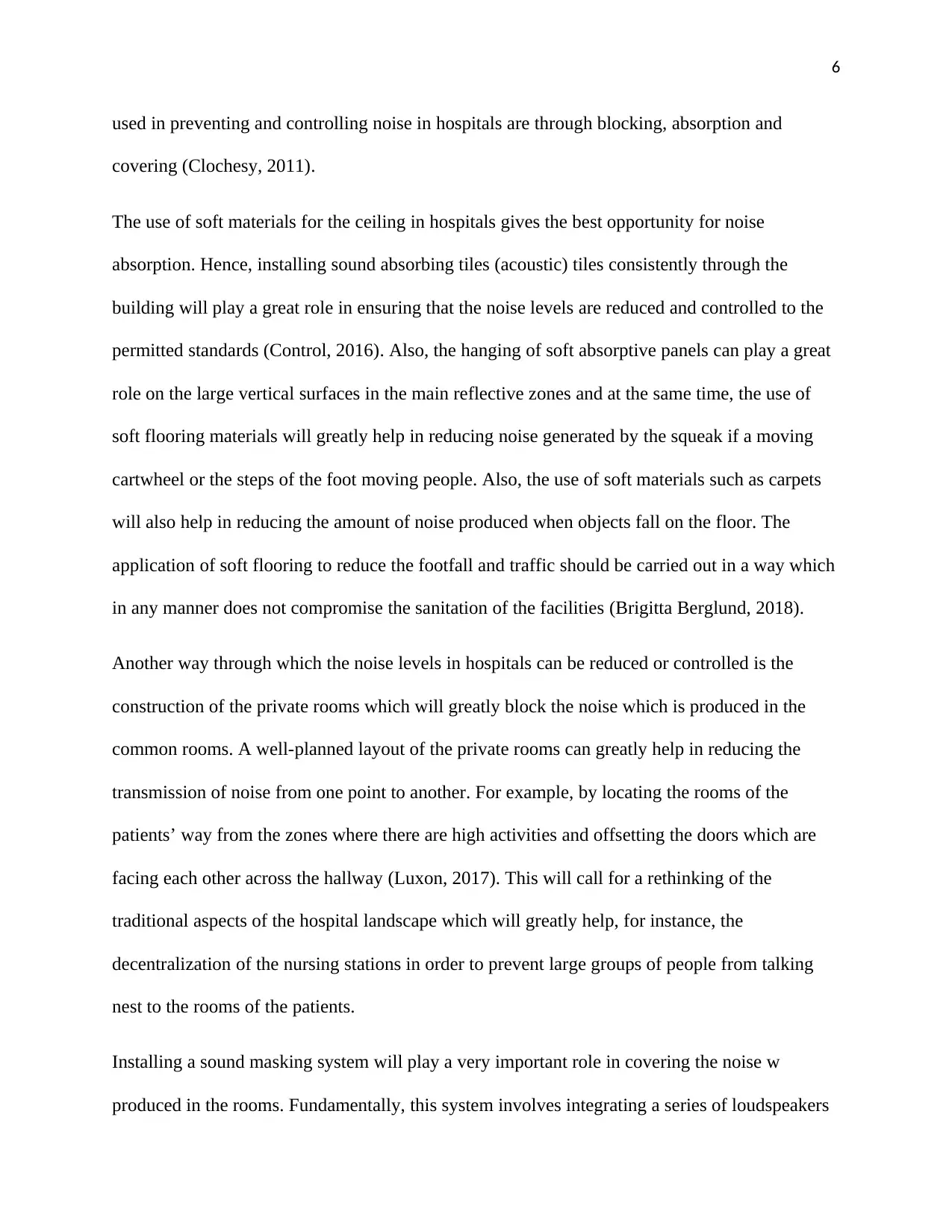
6
used in preventing and controlling noise in hospitals are through blocking, absorption and
covering (Clochesy, 2011).
The use of soft materials for the ceiling in hospitals gives the best opportunity for noise
absorption. Hence, installing sound absorbing tiles (acoustic) tiles consistently through the
building will play a great role in ensuring that the noise levels are reduced and controlled to the
permitted standards (Control, 2016). Also, the hanging of soft absorptive panels can play a great
role on the large vertical surfaces in the main reflective zones and at the same time, the use of
soft flooring materials will greatly help in reducing noise generated by the squeak if a moving
cartwheel or the steps of the foot moving people. Also, the use of soft materials such as carpets
will also help in reducing the amount of noise produced when objects fall on the floor. The
application of soft flooring to reduce the footfall and traffic should be carried out in a way which
in any manner does not compromise the sanitation of the facilities (Brigitta Berglund, 2018).
Another way through which the noise levels in hospitals can be reduced or controlled is the
construction of the private rooms which will greatly block the noise which is produced in the
common rooms. A well-planned layout of the private rooms can greatly help in reducing the
transmission of noise from one point to another. For example, by locating the rooms of the
patients’ way from the zones where there are high activities and offsetting the doors which are
facing each other across the hallway (Luxon, 2017). This will call for a rethinking of the
traditional aspects of the hospital landscape which will greatly help, for instance, the
decentralization of the nursing stations in order to prevent large groups of people from talking
nest to the rooms of the patients.
Installing a sound masking system will play a very important role in covering the noise w
produced in the rooms. Fundamentally, this system involves integrating a series of loudspeakers
used in preventing and controlling noise in hospitals are through blocking, absorption and
covering (Clochesy, 2011).
The use of soft materials for the ceiling in hospitals gives the best opportunity for noise
absorption. Hence, installing sound absorbing tiles (acoustic) tiles consistently through the
building will play a great role in ensuring that the noise levels are reduced and controlled to the
permitted standards (Control, 2016). Also, the hanging of soft absorptive panels can play a great
role on the large vertical surfaces in the main reflective zones and at the same time, the use of
soft flooring materials will greatly help in reducing noise generated by the squeak if a moving
cartwheel or the steps of the foot moving people. Also, the use of soft materials such as carpets
will also help in reducing the amount of noise produced when objects fall on the floor. The
application of soft flooring to reduce the footfall and traffic should be carried out in a way which
in any manner does not compromise the sanitation of the facilities (Brigitta Berglund, 2018).
Another way through which the noise levels in hospitals can be reduced or controlled is the
construction of the private rooms which will greatly block the noise which is produced in the
common rooms. A well-planned layout of the private rooms can greatly help in reducing the
transmission of noise from one point to another. For example, by locating the rooms of the
patients’ way from the zones where there are high activities and offsetting the doors which are
facing each other across the hallway (Luxon, 2017). This will call for a rethinking of the
traditional aspects of the hospital landscape which will greatly help, for instance, the
decentralization of the nursing stations in order to prevent large groups of people from talking
nest to the rooms of the patients.
Installing a sound masking system will play a very important role in covering the noise w
produced in the rooms. Fundamentally, this system involves integrating a series of loudspeakers
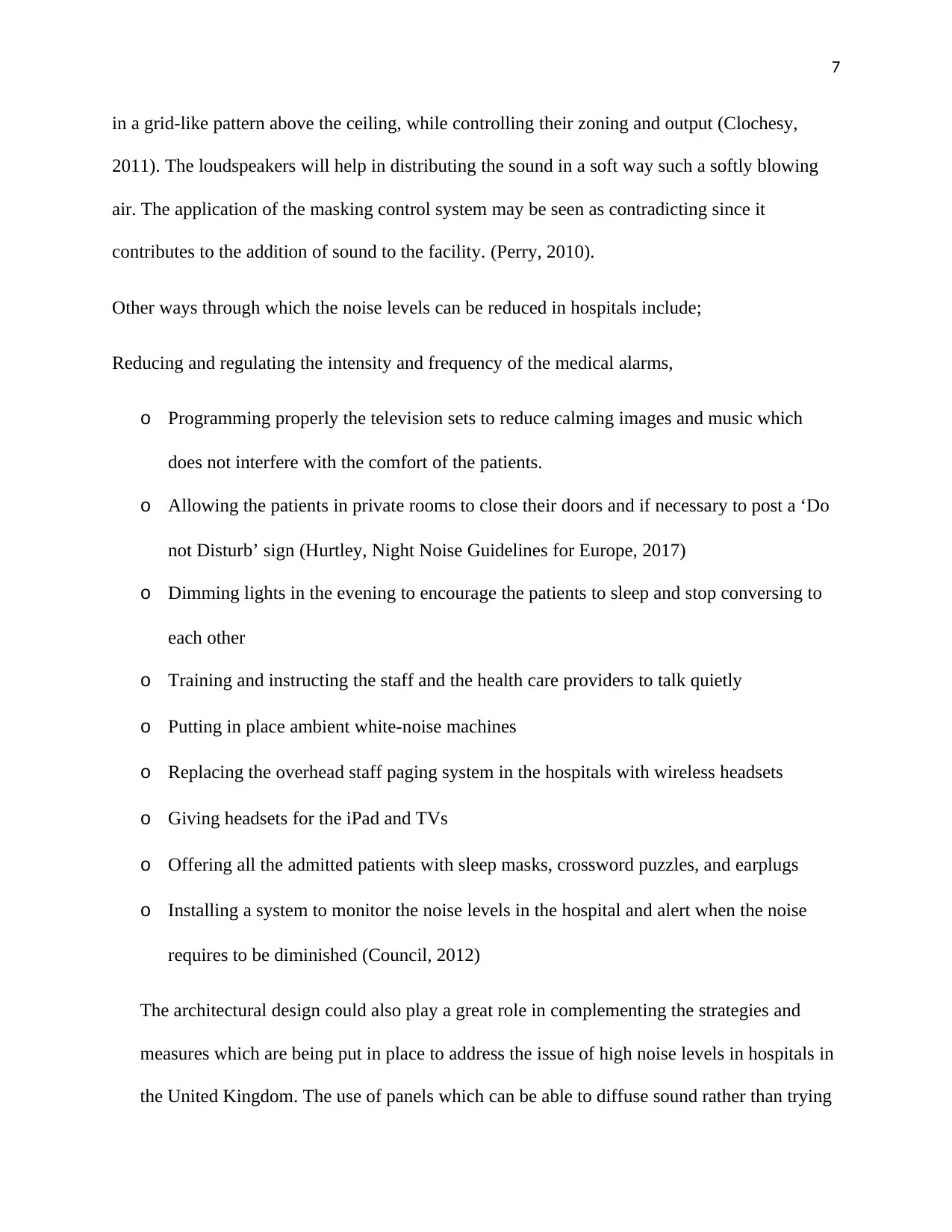
7
in a grid-like pattern above the ceiling, while controlling their zoning and output (Clochesy,
2011). The loudspeakers will help in distributing the sound in a soft way such a softly blowing
air. The application of the masking control system may be seen as contradicting since it
contributes to the addition of sound to the facility. (Perry, 2010).
Other ways through which the noise levels can be reduced in hospitals include;
Reducing and regulating the intensity and frequency of the medical alarms,
o Programming properly the television sets to reduce calming images and music which
does not interfere with the comfort of the patients.
o Allowing the patients in private rooms to close their doors and if necessary to post a ‘Do
not Disturb’ sign (Hurtley, Night Noise Guidelines for Europe, 2017)
o Dimming lights in the evening to encourage the patients to sleep and stop conversing to
each other
o Training and instructing the staff and the health care providers to talk quietly
o Putting in place ambient white-noise machines
o Replacing the overhead staff paging system in the hospitals with wireless headsets
o Giving headsets for the iPad and TVs
o Offering all the admitted patients with sleep masks, crossword puzzles, and earplugs
o Installing a system to monitor the noise levels in the hospital and alert when the noise
requires to be diminished (Council, 2012)
The architectural design could also play a great role in complementing the strategies and
measures which are being put in place to address the issue of high noise levels in hospitals in
the United Kingdom. The use of panels which can be able to diffuse sound rather than trying
in a grid-like pattern above the ceiling, while controlling their zoning and output (Clochesy,
2011). The loudspeakers will help in distributing the sound in a soft way such a softly blowing
air. The application of the masking control system may be seen as contradicting since it
contributes to the addition of sound to the facility. (Perry, 2010).
Other ways through which the noise levels can be reduced in hospitals include;
Reducing and regulating the intensity and frequency of the medical alarms,
o Programming properly the television sets to reduce calming images and music which
does not interfere with the comfort of the patients.
o Allowing the patients in private rooms to close their doors and if necessary to post a ‘Do
not Disturb’ sign (Hurtley, Night Noise Guidelines for Europe, 2017)
o Dimming lights in the evening to encourage the patients to sleep and stop conversing to
each other
o Training and instructing the staff and the health care providers to talk quietly
o Putting in place ambient white-noise machines
o Replacing the overhead staff paging system in the hospitals with wireless headsets
o Giving headsets for the iPad and TVs
o Offering all the admitted patients with sleep masks, crossword puzzles, and earplugs
o Installing a system to monitor the noise levels in the hospital and alert when the noise
requires to be diminished (Council, 2012)
The architectural design could also play a great role in complementing the strategies and
measures which are being put in place to address the issue of high noise levels in hospitals in
the United Kingdom. The use of panels which can be able to diffuse sound rather than trying
Paraphrase This Document
Need a fresh take? Get an instant paraphrase of this document with our AI Paraphraser
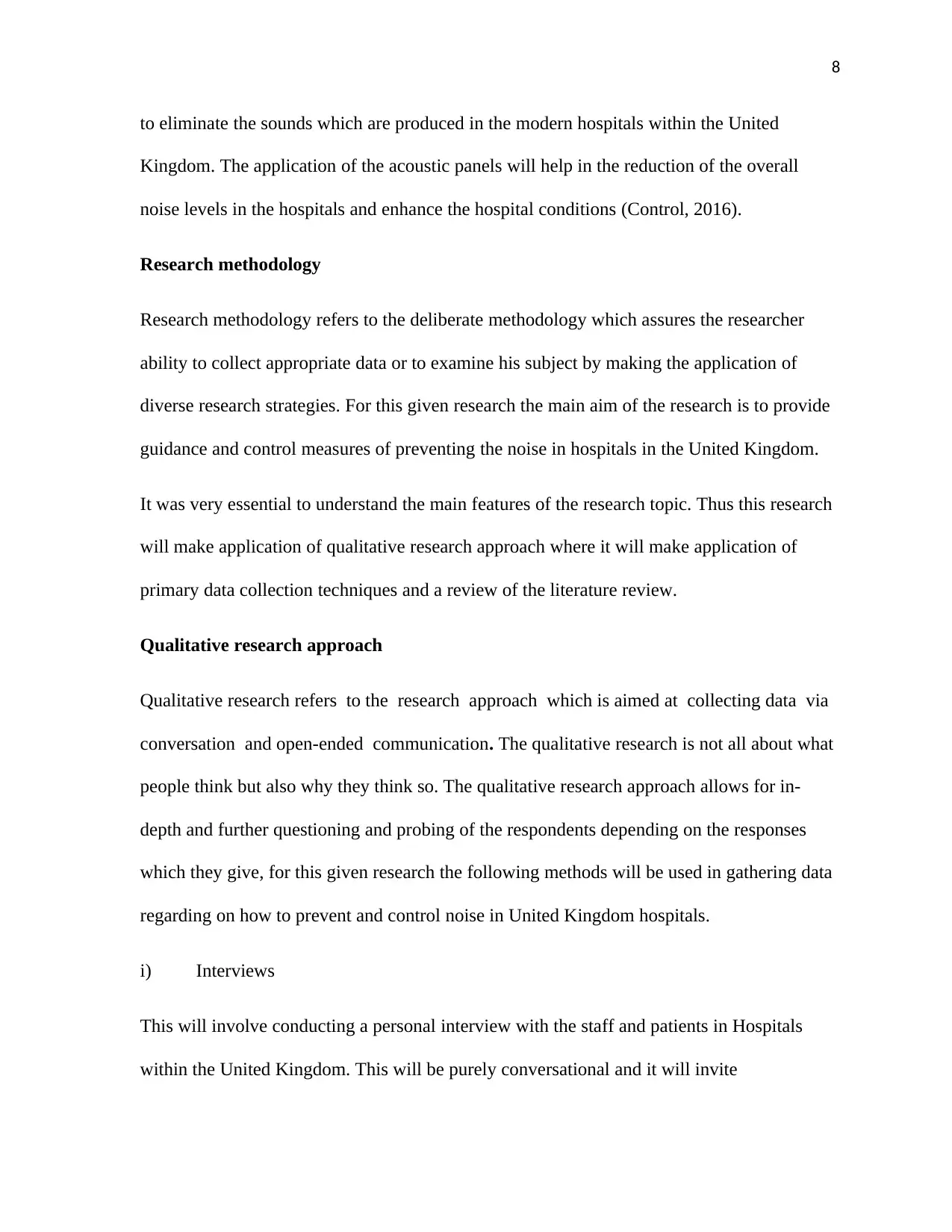
8
to eliminate the sounds which are produced in the modern hospitals within the United
Kingdom. The application of the acoustic panels will help in the reduction of the overall
noise levels in the hospitals and enhance the hospital conditions (Control, 2016).
Research methodology
Research methodology refers to the deliberate methodology which assures the researcher
ability to collect appropriate data or to examine his subject by making the application of
diverse research strategies. For this given research the main aim of the research is to provide
guidance and control measures of preventing the noise in hospitals in the United Kingdom.
It was very essential to understand the main features of the research topic. Thus this research
will make application of qualitative research approach where it will make application of
primary data collection techniques and a review of the literature review.
Qualitative research approach
Qualitative research refers to the research approach which is aimed at collecting data via
conversation and open-ended communication. The qualitative research is not all about what
people think but also why they think so. The qualitative research approach allows for in-
depth and further questioning and probing of the respondents depending on the responses
which they give, for this given research the following methods will be used in gathering data
regarding on how to prevent and control noise in United Kingdom hospitals.
i) Interviews
This will involve conducting a personal interview with the staff and patients in Hospitals
within the United Kingdom. This will be purely conversational and it will invite
to eliminate the sounds which are produced in the modern hospitals within the United
Kingdom. The application of the acoustic panels will help in the reduction of the overall
noise levels in the hospitals and enhance the hospital conditions (Control, 2016).
Research methodology
Research methodology refers to the deliberate methodology which assures the researcher
ability to collect appropriate data or to examine his subject by making the application of
diverse research strategies. For this given research the main aim of the research is to provide
guidance and control measures of preventing the noise in hospitals in the United Kingdom.
It was very essential to understand the main features of the research topic. Thus this research
will make application of qualitative research approach where it will make application of
primary data collection techniques and a review of the literature review.
Qualitative research approach
Qualitative research refers to the research approach which is aimed at collecting data via
conversation and open-ended communication. The qualitative research is not all about what
people think but also why they think so. The qualitative research approach allows for in-
depth and further questioning and probing of the respondents depending on the responses
which they give, for this given research the following methods will be used in gathering data
regarding on how to prevent and control noise in United Kingdom hospitals.
i) Interviews
This will involve conducting a personal interview with the staff and patients in Hospitals
within the United Kingdom. This will be purely conversational and it will invite
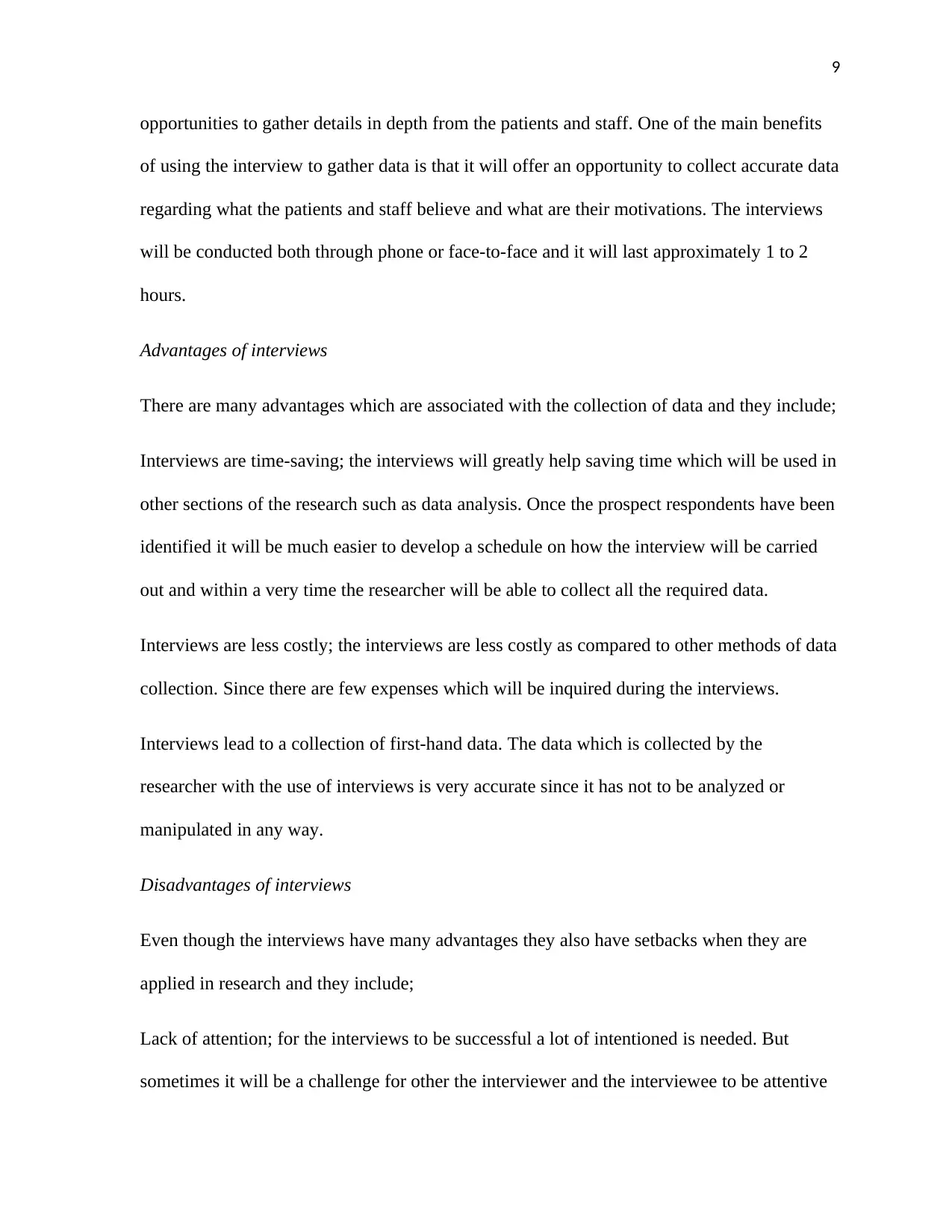
9
opportunities to gather details in depth from the patients and staff. One of the main benefits
of using the interview to gather data is that it will offer an opportunity to collect accurate data
regarding what the patients and staff believe and what are their motivations. The interviews
will be conducted both through phone or face-to-face and it will last approximately 1 to 2
hours.
Advantages of interviews
There are many advantages which are associated with the collection of data and they include;
Interviews are time-saving; the interviews will greatly help saving time which will be used in
other sections of the research such as data analysis. Once the prospect respondents have been
identified it will be much easier to develop a schedule on how the interview will be carried
out and within a very time the researcher will be able to collect all the required data.
Interviews are less costly; the interviews are less costly as compared to other methods of data
collection. Since there are few expenses which will be inquired during the interviews.
Interviews lead to a collection of first-hand data. The data which is collected by the
researcher with the use of interviews is very accurate since it has not to be analyzed or
manipulated in any way.
Disadvantages of interviews
Even though the interviews have many advantages they also have setbacks when they are
applied in research and they include;
Lack of attention; for the interviews to be successful a lot of intentioned is needed. But
sometimes it will be a challenge for other the interviewer and the interviewee to be attentive
opportunities to gather details in depth from the patients and staff. One of the main benefits
of using the interview to gather data is that it will offer an opportunity to collect accurate data
regarding what the patients and staff believe and what are their motivations. The interviews
will be conducted both through phone or face-to-face and it will last approximately 1 to 2
hours.
Advantages of interviews
There are many advantages which are associated with the collection of data and they include;
Interviews are time-saving; the interviews will greatly help saving time which will be used in
other sections of the research such as data analysis. Once the prospect respondents have been
identified it will be much easier to develop a schedule on how the interview will be carried
out and within a very time the researcher will be able to collect all the required data.
Interviews are less costly; the interviews are less costly as compared to other methods of data
collection. Since there are few expenses which will be inquired during the interviews.
Interviews lead to a collection of first-hand data. The data which is collected by the
researcher with the use of interviews is very accurate since it has not to be analyzed or
manipulated in any way.
Disadvantages of interviews
Even though the interviews have many advantages they also have setbacks when they are
applied in research and they include;
Lack of attention; for the interviews to be successful a lot of intentioned is needed. But
sometimes it will be a challenge for other the interviewer and the interviewee to be attentive
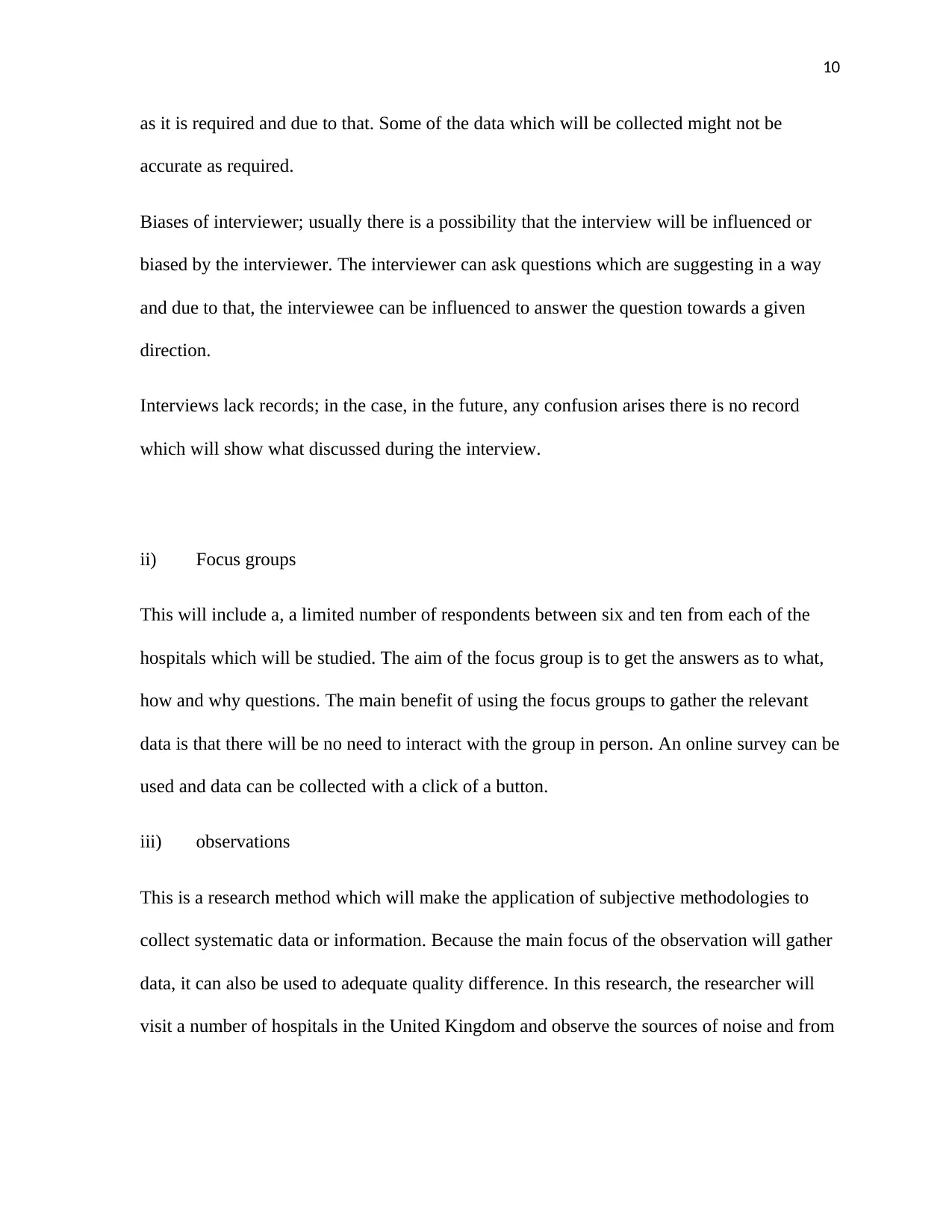
10
as it is required and due to that. Some of the data which will be collected might not be
accurate as required.
Biases of interviewer; usually there is a possibility that the interview will be influenced or
biased by the interviewer. The interviewer can ask questions which are suggesting in a way
and due to that, the interviewee can be influenced to answer the question towards a given
direction.
Interviews lack records; in the case, in the future, any confusion arises there is no record
which will show what discussed during the interview.
ii) Focus groups
This will include a, a limited number of respondents between six and ten from each of the
hospitals which will be studied. The aim of the focus group is to get the answers as to what,
how and why questions. The main benefit of using the focus groups to gather the relevant
data is that there will be no need to interact with the group in person. An online survey can be
used and data can be collected with a click of a button.
iii) observations
This is a research method which will make the application of subjective methodologies to
collect systematic data or information. Because the main focus of the observation will gather
data, it can also be used to adequate quality difference. In this research, the researcher will
visit a number of hospitals in the United Kingdom and observe the sources of noise and from
as it is required and due to that. Some of the data which will be collected might not be
accurate as required.
Biases of interviewer; usually there is a possibility that the interview will be influenced or
biased by the interviewer. The interviewer can ask questions which are suggesting in a way
and due to that, the interviewee can be influenced to answer the question towards a given
direction.
Interviews lack records; in the case, in the future, any confusion arises there is no record
which will show what discussed during the interview.
ii) Focus groups
This will include a, a limited number of respondents between six and ten from each of the
hospitals which will be studied. The aim of the focus group is to get the answers as to what,
how and why questions. The main benefit of using the focus groups to gather the relevant
data is that there will be no need to interact with the group in person. An online survey can be
used and data can be collected with a click of a button.
iii) observations
This is a research method which will make the application of subjective methodologies to
collect systematic data or information. Because the main focus of the observation will gather
data, it can also be used to adequate quality difference. In this research, the researcher will
visit a number of hospitals in the United Kingdom and observe the sources of noise and from
Secure Best Marks with AI Grader
Need help grading? Try our AI Grader for instant feedback on your assignments.
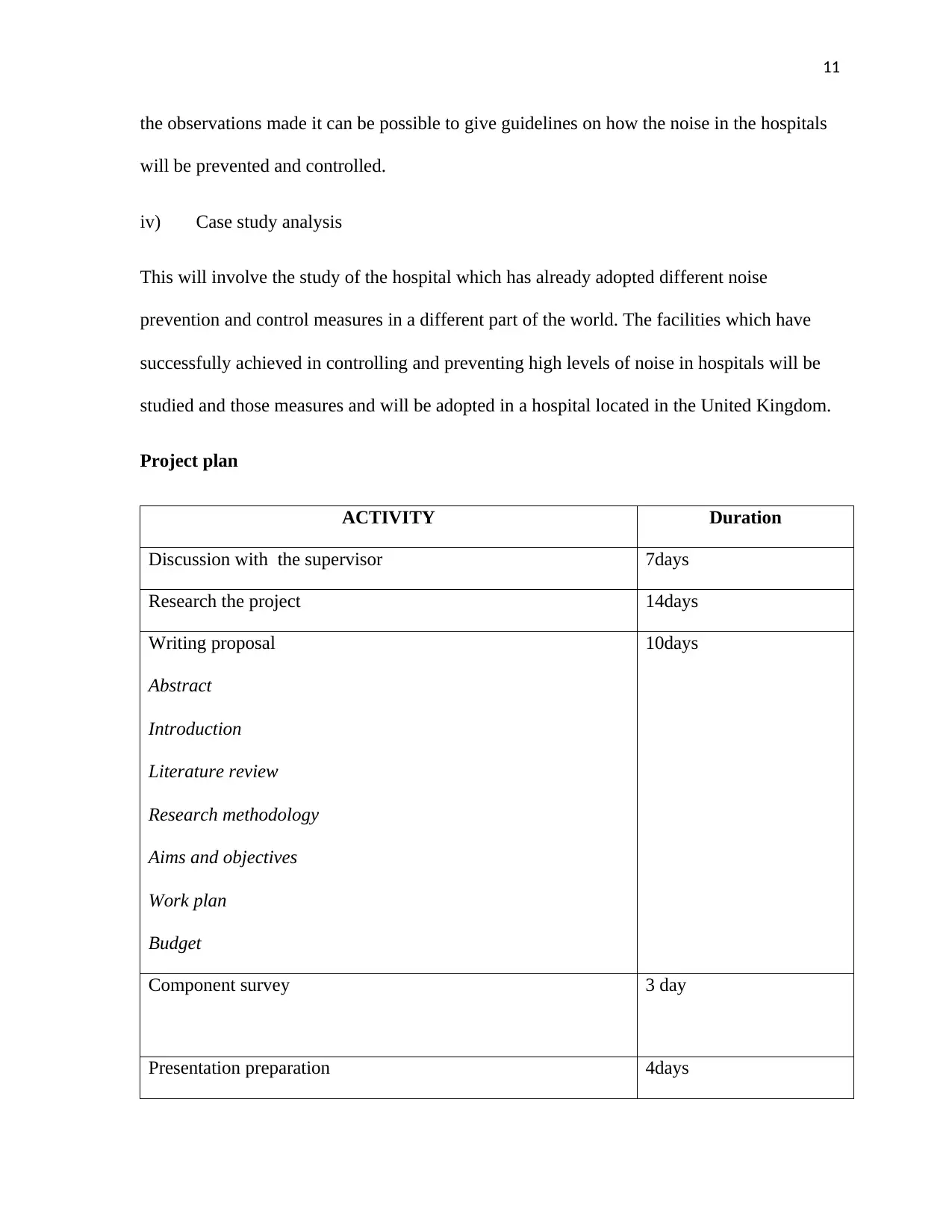
11
the observations made it can be possible to give guidelines on how the noise in the hospitals
will be prevented and controlled.
iv) Case study analysis
This will involve the study of the hospital which has already adopted different noise
prevention and control measures in a different part of the world. The facilities which have
successfully achieved in controlling and preventing high levels of noise in hospitals will be
studied and those measures and will be adopted in a hospital located in the United Kingdom.
Project plan
ACTIVITY Duration
Discussion with the supervisor 7days
Research the project 14days
Writing proposal
Abstract
Introduction
Literature review
Research methodology
Aims and objectives
Work plan
Budget
10days
Component survey 3 day
Presentation preparation 4days
the observations made it can be possible to give guidelines on how the noise in the hospitals
will be prevented and controlled.
iv) Case study analysis
This will involve the study of the hospital which has already adopted different noise
prevention and control measures in a different part of the world. The facilities which have
successfully achieved in controlling and preventing high levels of noise in hospitals will be
studied and those measures and will be adopted in a hospital located in the United Kingdom.
Project plan
ACTIVITY Duration
Discussion with the supervisor 7days
Research the project 14days
Writing proposal
Abstract
Introduction
Literature review
Research methodology
Aims and objectives
Work plan
Budget
10days
Component survey 3 day
Presentation preparation 4days
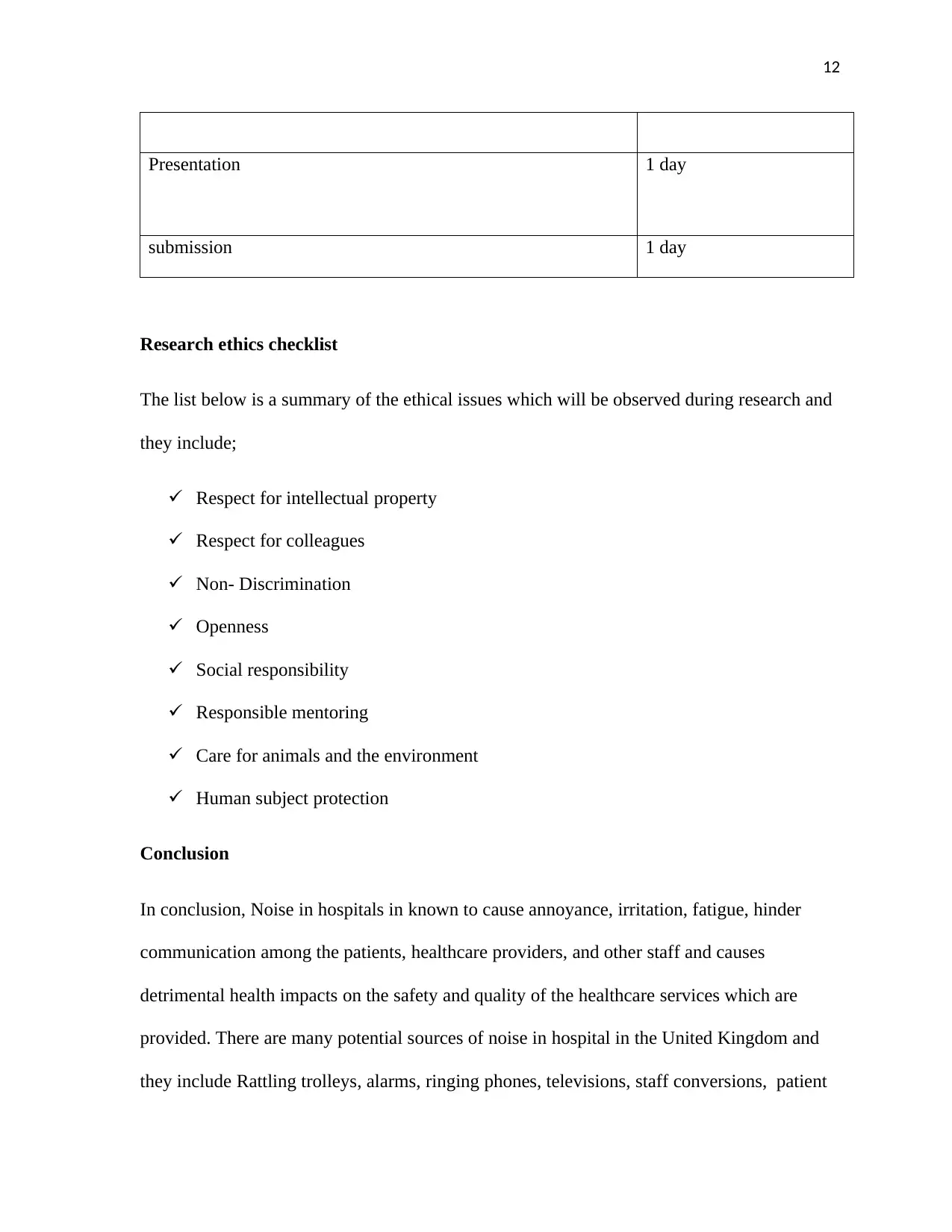
12
Presentation 1 day
submission 1 day
Research ethics checklist
The list below is a summary of the ethical issues which will be observed during research and
they include;
Respect for intellectual property
Respect for colleagues
Non- Discrimination
Openness
Social responsibility
Responsible mentoring
Care for animals and the environment
Human subject protection
Conclusion
In conclusion, Noise in hospitals in known to cause annoyance, irritation, fatigue, hinder
communication among the patients, healthcare providers, and other staff and causes
detrimental health impacts on the safety and quality of the healthcare services which are
provided. There are many potential sources of noise in hospital in the United Kingdom and
they include Rattling trolleys, alarms, ringing phones, televisions, staff conversions, patient
Presentation 1 day
submission 1 day
Research ethics checklist
The list below is a summary of the ethical issues which will be observed during research and
they include;
Respect for intellectual property
Respect for colleagues
Non- Discrimination
Openness
Social responsibility
Responsible mentoring
Care for animals and the environment
Human subject protection
Conclusion
In conclusion, Noise in hospitals in known to cause annoyance, irritation, fatigue, hinder
communication among the patients, healthcare providers, and other staff and causes
detrimental health impacts on the safety and quality of the healthcare services which are
provided. There are many potential sources of noise in hospital in the United Kingdom and
they include Rattling trolleys, alarms, ringing phones, televisions, staff conversions, patient
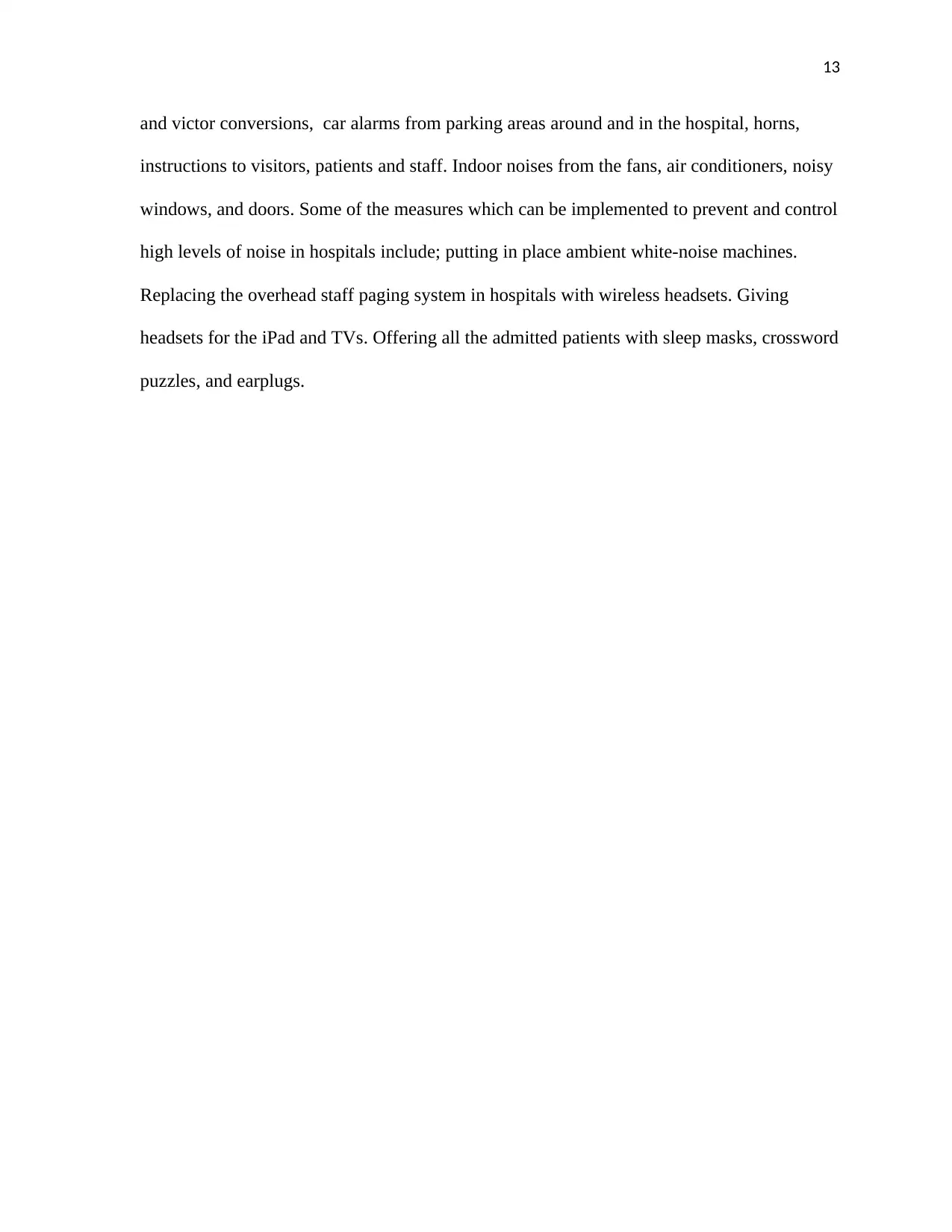
13
and victor conversions, car alarms from parking areas around and in the hospital, horns,
instructions to visitors, patients and staff. Indoor noises from the fans, air conditioners, noisy
windows, and doors. Some of the measures which can be implemented to prevent and control
high levels of noise in hospitals include; putting in place ambient white-noise machines.
Replacing the overhead staff paging system in hospitals with wireless headsets. Giving
headsets for the iPad and TVs. Offering all the admitted patients with sleep masks, crossword
puzzles, and earplugs.
and victor conversions, car alarms from parking areas around and in the hospital, horns,
instructions to visitors, patients and staff. Indoor noises from the fans, air conditioners, noisy
windows, and doors. Some of the measures which can be implemented to prevent and control
high levels of noise in hospitals include; putting in place ambient white-noise machines.
Replacing the overhead staff paging system in hospitals with wireless headsets. Giving
headsets for the iPad and TVs. Offering all the admitted patients with sleep masks, crossword
puzzles, and earplugs.
Paraphrase This Document
Need a fresh take? Get an instant paraphrase of this document with our AI Paraphraser
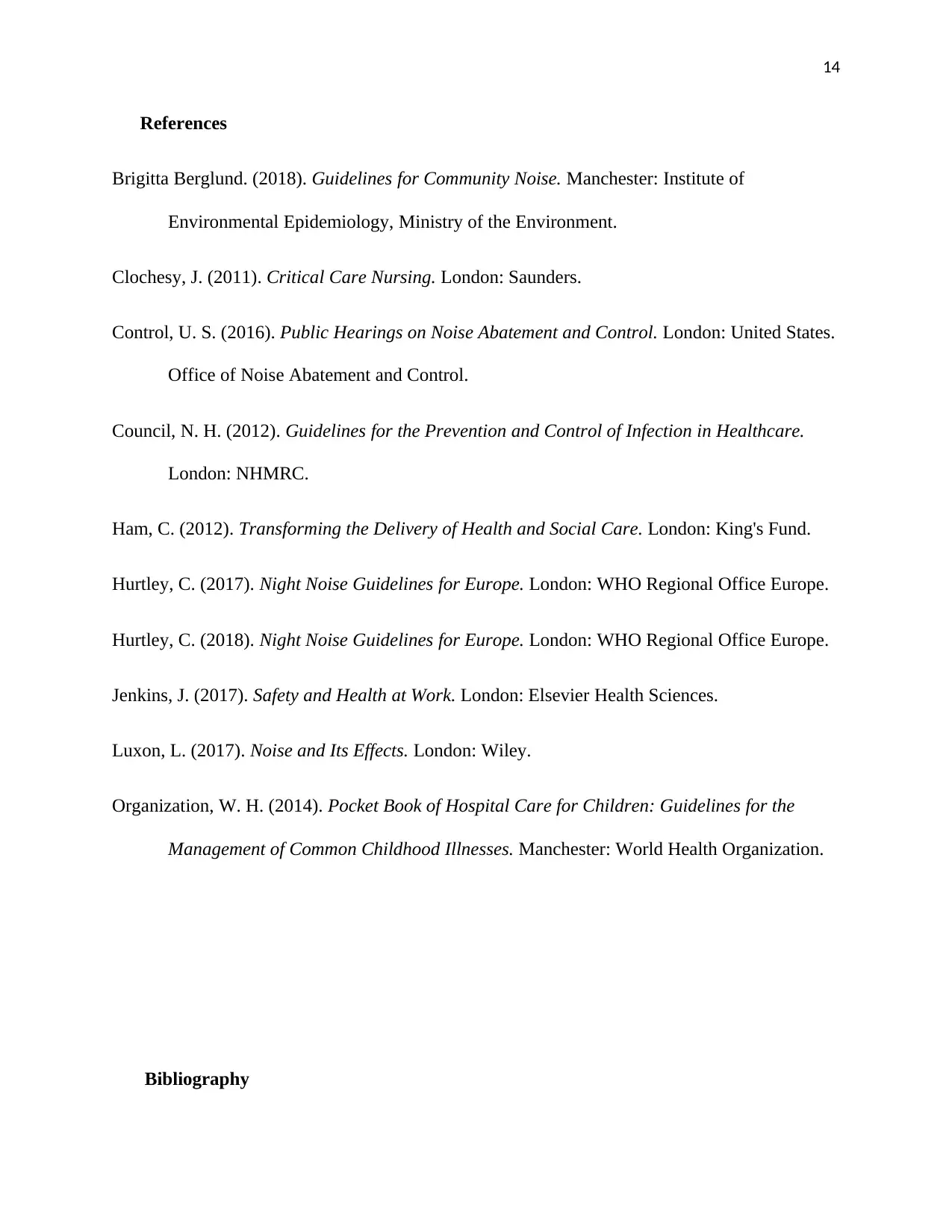
14
References
Brigitta Berglund. (2018). Guidelines for Community Noise. Manchester: Institute of
Environmental Epidemiology, Ministry of the Environment.
Clochesy, J. (2011). Critical Care Nursing. London: Saunders.
Control, U. S. (2016). Public Hearings on Noise Abatement and Control. London: United States.
Office of Noise Abatement and Control.
Council, N. H. (2012). Guidelines for the Prevention and Control of Infection in Healthcare.
London: NHMRC.
Ham, C. (2012). Transforming the Delivery of Health and Social Care. London: King's Fund.
Hurtley, C. (2017). Night Noise Guidelines for Europe. London: WHO Regional Office Europe.
Hurtley, C. (2018). Night Noise Guidelines for Europe. London: WHO Regional Office Europe.
Jenkins, J. (2017). Safety and Health at Work. London: Elsevier Health Sciences.
Luxon, L. (2017). Noise and Its Effects. London: Wiley.
Organization, W. H. (2014). Pocket Book of Hospital Care for Children: Guidelines for the
Management of Common Childhood Illnesses. Manchester: World Health Organization.
Bibliography
References
Brigitta Berglund. (2018). Guidelines for Community Noise. Manchester: Institute of
Environmental Epidemiology, Ministry of the Environment.
Clochesy, J. (2011). Critical Care Nursing. London: Saunders.
Control, U. S. (2016). Public Hearings on Noise Abatement and Control. London: United States.
Office of Noise Abatement and Control.
Council, N. H. (2012). Guidelines for the Prevention and Control of Infection in Healthcare.
London: NHMRC.
Ham, C. (2012). Transforming the Delivery of Health and Social Care. London: King's Fund.
Hurtley, C. (2017). Night Noise Guidelines for Europe. London: WHO Regional Office Europe.
Hurtley, C. (2018). Night Noise Guidelines for Europe. London: WHO Regional Office Europe.
Jenkins, J. (2017). Safety and Health at Work. London: Elsevier Health Sciences.
Luxon, L. (2017). Noise and Its Effects. London: Wiley.
Organization, W. H. (2014). Pocket Book of Hospital Care for Children: Guidelines for the
Management of Common Childhood Illnesses. Manchester: World Health Organization.
Bibliography
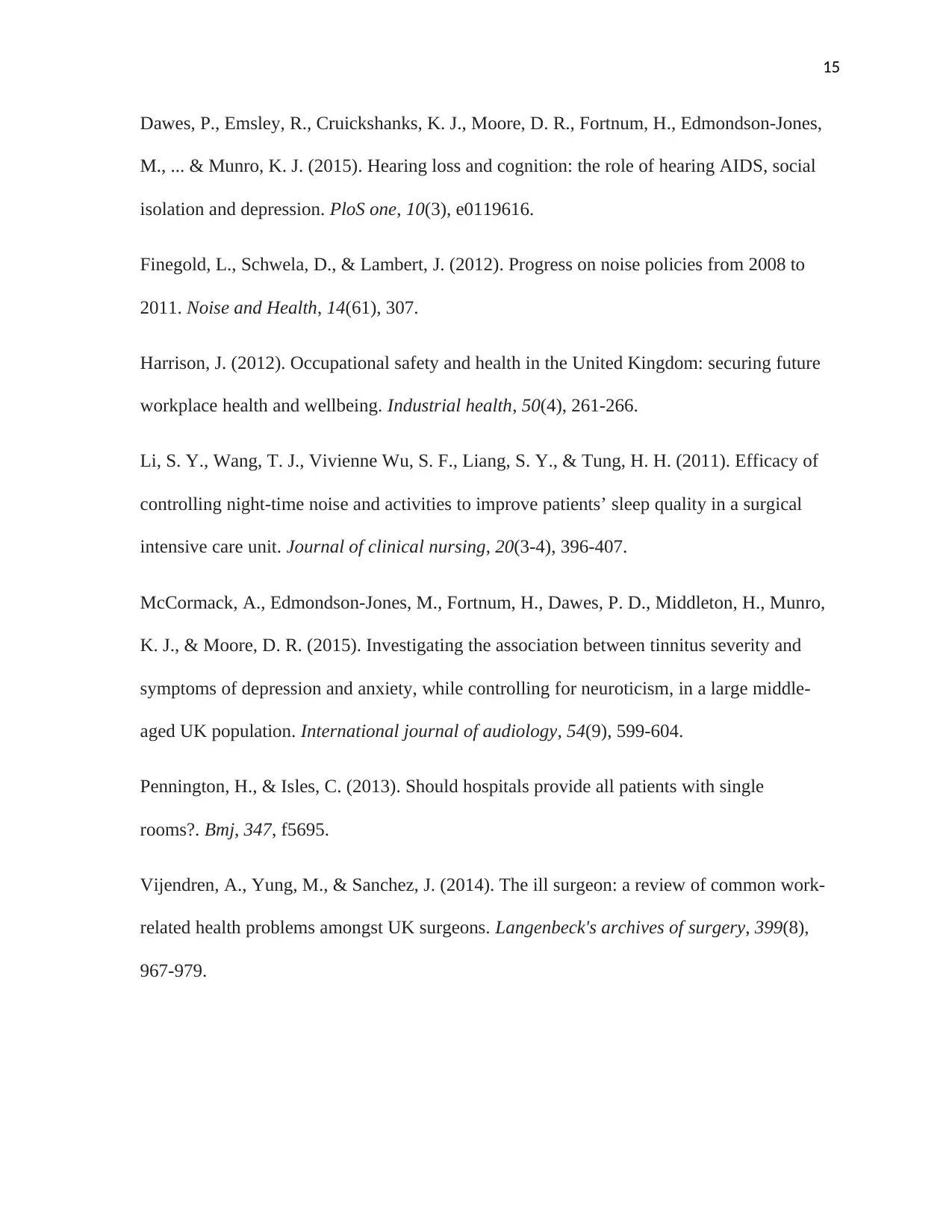
15
Dawes, P., Emsley, R., Cruickshanks, K. J., Moore, D. R., Fortnum, H., Edmondson-Jones,
M., ... & Munro, K. J. (2015). Hearing loss and cognition: the role of hearing AIDS, social
isolation and depression. PloS one, 10(3), e0119616.
Finegold, L., Schwela, D., & Lambert, J. (2012). Progress on noise policies from 2008 to
2011. Noise and Health, 14(61), 307.
Harrison, J. (2012). Occupational safety and health in the United Kingdom: securing future
workplace health and wellbeing. Industrial health, 50(4), 261-266.
Li, S. Y., Wang, T. J., Vivienne Wu, S. F., Liang, S. Y., & Tung, H. H. (2011). Efficacy of
controlling night‐time noise and activities to improve patients’ sleep quality in a surgical
intensive care unit. Journal of clinical nursing, 20(3‐4), 396-407.
McCormack, A., Edmondson-Jones, M., Fortnum, H., Dawes, P. D., Middleton, H., Munro,
K. J., & Moore, D. R. (2015). Investigating the association between tinnitus severity and
symptoms of depression and anxiety, while controlling for neuroticism, in a large middle-
aged UK population. International journal of audiology, 54(9), 599-604.
Pennington, H., & Isles, C. (2013). Should hospitals provide all patients with single
rooms?. Bmj, 347, f5695.
Vijendren, A., Yung, M., & Sanchez, J. (2014). The ill surgeon: a review of common work-
related health problems amongst UK surgeons. Langenbeck's archives of surgery, 399(8),
967-979.
Dawes, P., Emsley, R., Cruickshanks, K. J., Moore, D. R., Fortnum, H., Edmondson-Jones,
M., ... & Munro, K. J. (2015). Hearing loss and cognition: the role of hearing AIDS, social
isolation and depression. PloS one, 10(3), e0119616.
Finegold, L., Schwela, D., & Lambert, J. (2012). Progress on noise policies from 2008 to
2011. Noise and Health, 14(61), 307.
Harrison, J. (2012). Occupational safety and health in the United Kingdom: securing future
workplace health and wellbeing. Industrial health, 50(4), 261-266.
Li, S. Y., Wang, T. J., Vivienne Wu, S. F., Liang, S. Y., & Tung, H. H. (2011). Efficacy of
controlling night‐time noise and activities to improve patients’ sleep quality in a surgical
intensive care unit. Journal of clinical nursing, 20(3‐4), 396-407.
McCormack, A., Edmondson-Jones, M., Fortnum, H., Dawes, P. D., Middleton, H., Munro,
K. J., & Moore, D. R. (2015). Investigating the association between tinnitus severity and
symptoms of depression and anxiety, while controlling for neuroticism, in a large middle-
aged UK population. International journal of audiology, 54(9), 599-604.
Pennington, H., & Isles, C. (2013). Should hospitals provide all patients with single
rooms?. Bmj, 347, f5695.
Vijendren, A., Yung, M., & Sanchez, J. (2014). The ill surgeon: a review of common work-
related health problems amongst UK surgeons. Langenbeck's archives of surgery, 399(8),
967-979.
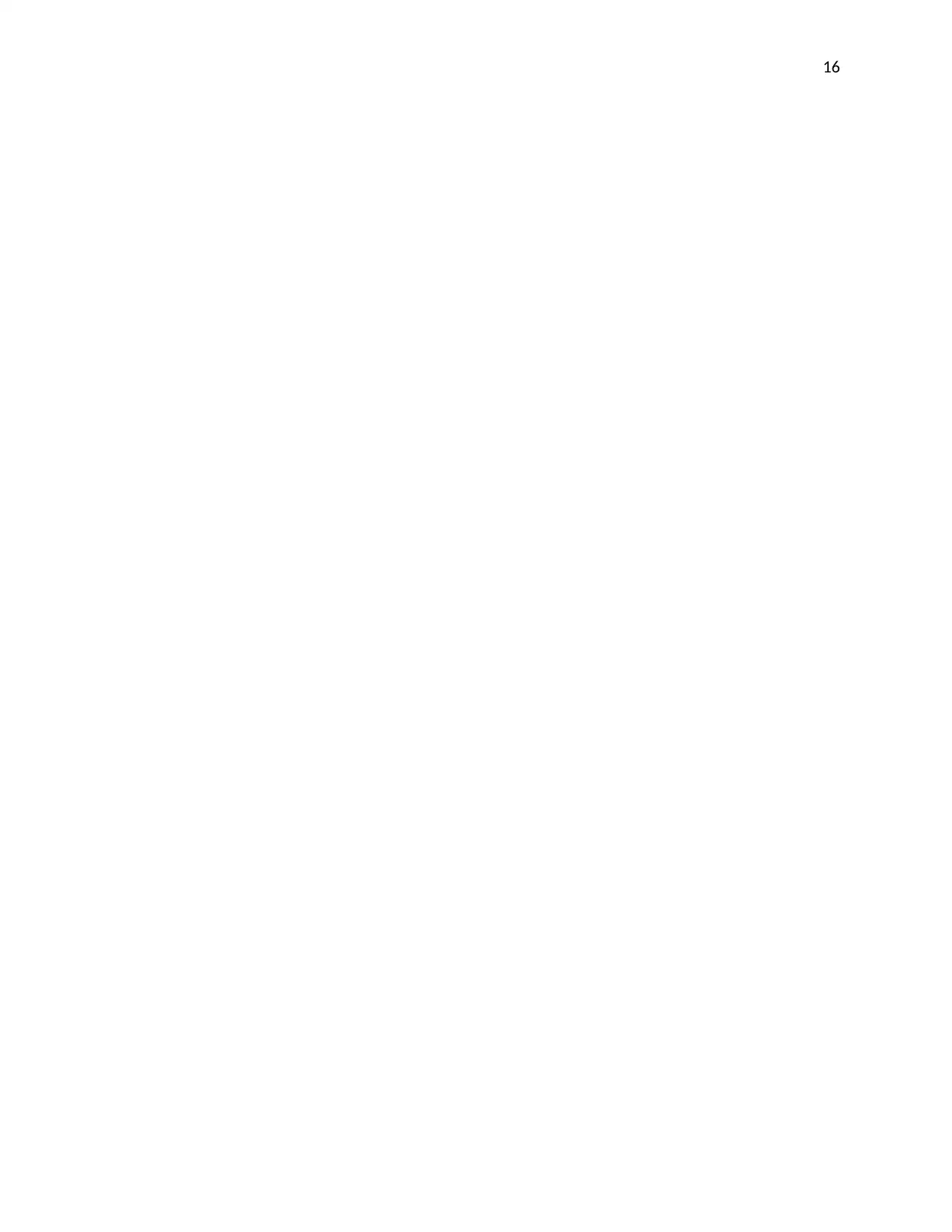
16
1 out of 16
Your All-in-One AI-Powered Toolkit for Academic Success.
+13062052269
info@desklib.com
Available 24*7 on WhatsApp / Email
![[object Object]](/_next/static/media/star-bottom.7253800d.svg)
Unlock your academic potential
© 2024 | Zucol Services PVT LTD | All rights reserved.

